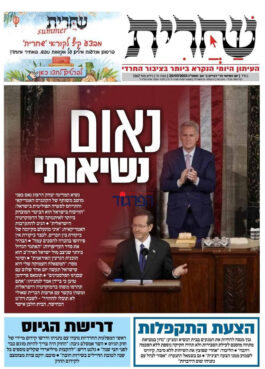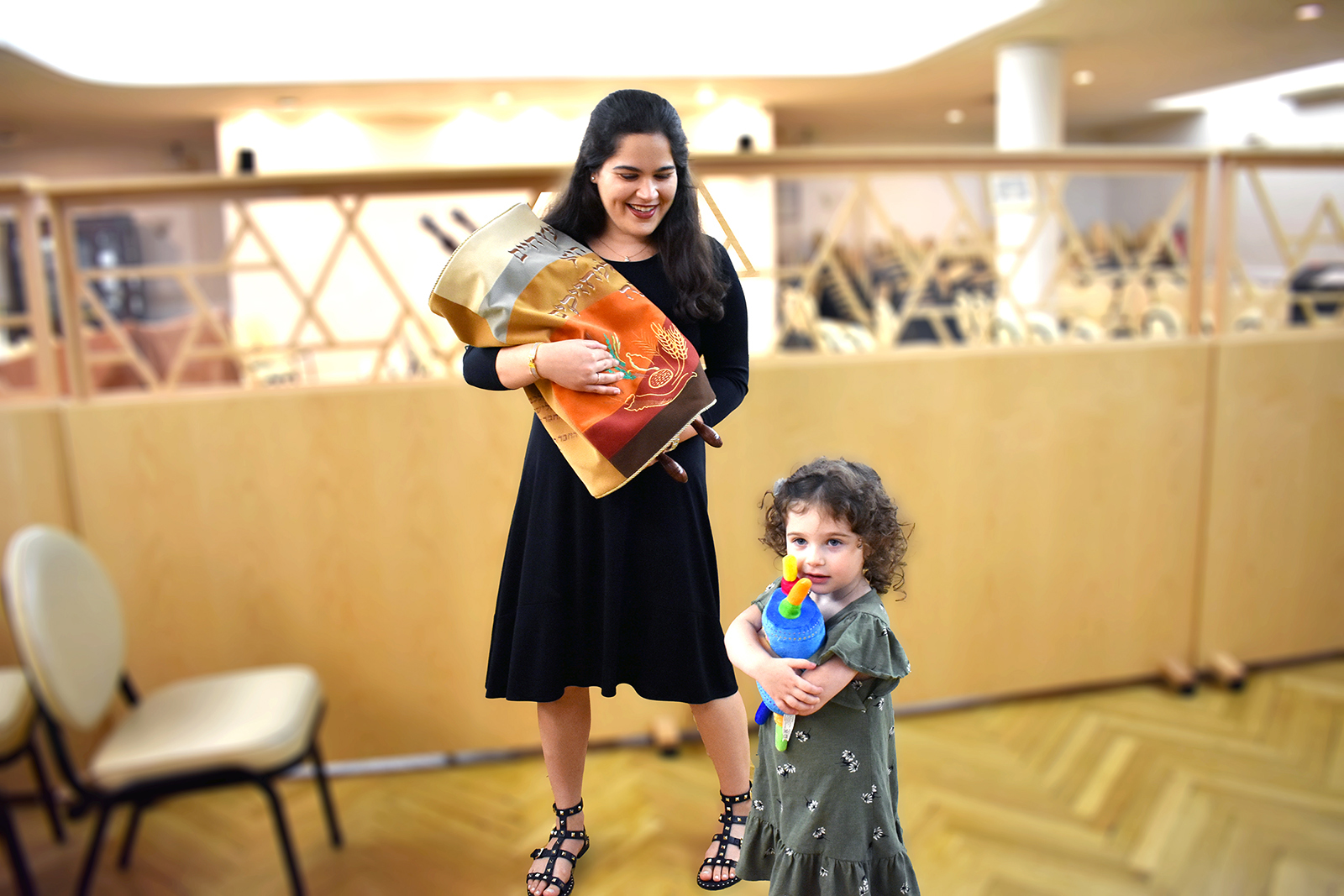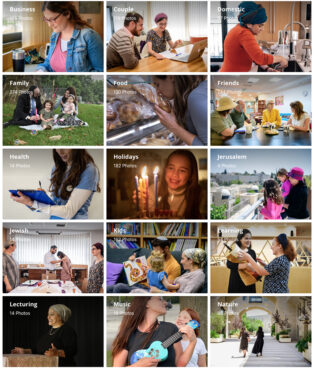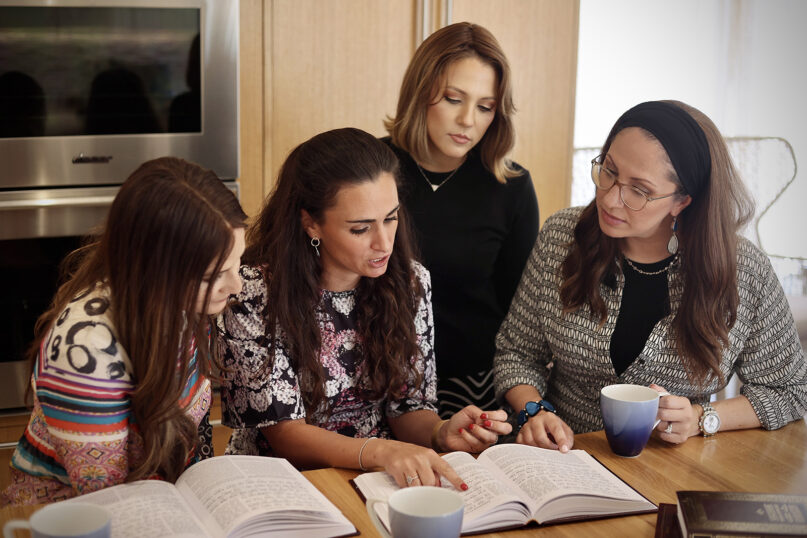JERUSALEM (RNS) — For more than a decade, Shoshanna Keats Jaskoll, an Orthodox Jewish feminist, has been chronicling the gradual disappearance of women from magazines, advertisements and other media in Israel as modesty customs spread beyond the Orthodox Jewish world.
“It’s been happening in the private Orthodox sphere, where magazines and advertisements and circulars don’t include photos of women and girls. It’s become the norm,” Jaskoll says. “It started with showing women in modest clothing, to blurring women in pictures, to completely taking them out.”
The trend began in the 1990s as Haredi and even some mainstream Orthodox communities in Israel and abroad embraced a more stringent definition of religious modesty.

The ultra-Orthodox Israeli newspaper Shacharit covered Israeli President Isaac Herzog’s July 19, 2023, address to the U.S. Congress in Washington, but erased Vice President Kamala Harris when it ran an article. Screen grab
In response, some fervently Orthodox men demanded that women sit in the back of public buses so as not to come in contact with men, a practice Israel’s Supreme Court deemed illegal.
Eventually, the guidelines on modesty spread to some segments of the non-Orthodox world, especially businesses and organizations with Orthodox clients.
From 2004 to 2012, Israel’s largest transportation company, Egged, stopped running advertisements with women’s photos in Jerusalem after the ads were repeatedly defaced. In 2017, the furniture manufacturer Ikea created an alternative Israeli catalog without a single photo of a woman. Both Egged and Ikea backtracked after public pressure.
But against the urging of women’s rights and human rights organizations, many non-Orthodox businesses, banks, cellphone companies, health maintenance organizations and even government agencies continue to show only men in their advertising, at least in some locations.
Determined to return women’s images to the public sphere, Jaskoll has created a unique photo bank of religious Jewish women and their families. Launched by the religious women’s advocacy organization Chochmat Nashim, the Jewish Life Photo Bank has become a resource for positive images of religious Jewish women.
Jaskoll came up with the idea after public relations consultant Rachel Moore, a friend, complained about the near impossibility of finding high-quality photos of religious women for her clients.
“I was consistently looking for creative ways to make content that wasn’t necessarily targeted to a religious demographic, but that showed regular people doing regular things while not half-dressed,” Moore says.

An Orthodox Jewish woman holds a Torah scroll as her daughter hugs a toy Torah. Photo by Fruma Landa, courtesy Jewish Life Photo Bank
The typical stock photos available from Israeli and international photo banks depict women in clothes that many Orthodox Jews would consider immodest: tight pants and other figure-hugging clothing; sleeveless, often low-cut shirts or dresses; and above-the-knee skirts or shorts.
The few available stock photos of Orthodox people, meanwhile, are usually of men and boys, often in prayer, with few images of women.
To jump-start the project, Jaskoll put out an online call to Orthodox women to ask if they would agree to be photographed performing their day-to-day activities.
“The response was incredible,” Jaskoll said. Within 48 hours more than 250 women in several countries had volunteered to model or photograph others, or offered a space for a photo shoot. Photo shoots have taken place in Israel, the U.S., England and France.

A variety of the photo categories available at the Jewish Life Photo Bank. Screen grab
The photo bank offers images in 35 categories, including parenting, Torah learning, holidays, family, business and sport. Many show Orthodox women in settings where they are often present but rarely photographed — engaging in business meetings, lecturing at a synagogue, studying religious texts, holding or praying from a Torah, playing tennis or touch football.
Others depict couples or families in scenes Haredi publications don’t publish, even when a couple is being honored together at a fundraiser.
While the photo bank hasn’t yet had a measurable impact within the Orthodox world, the Jewish Press, a mainstream Orthodox paper in New York, is a subscriber.
“The bank is a great resource because it features pictures of frum (religiously observant) people in frum settings that we’re able to use without reservation,” says Shlomo Greenwald, editor of the paper’s print edition.
In all, since going live in late 2021, the bank has sold 22 all-access subscriptions, 129 multi-image packages and hundreds of individual photos.
“We are happy to support one of the photo bank’s goals, which is to help increase female representation in Orthodox media, where it is sorely lacking in some places,” Greenwald added.
Keren David, managing editor of the London-based Jewish Chronicle, a weekly newspaper with a religiously mixed readership, subscribes to the bank because “it’s difficult to source authentic photos of Jewish life. We’re not the sort of newspaper that is happy with the ‘men only’ images used by some papers.”

Many Orthodox women exercise and play sports. Photo by Adina Levitan, courtesy Jewish Life Photo Bank
Although she supports Orthodox women’s visibility, Elana Sztokman, a feminist activist and author of the 2015 book “The War on Women in Israel,” notes that “the erasure of women isn’t only about Orthodox women. While I’m all for newspapers writing about and including photos of Orthodox women, we should shift the focus to say we need to write more about all women, their opinions and achievements.”
Jaskoll understands Sztokman’s concerns but says that Orthodox women are in a uniquely difficult position. “Yes, the Orthodox media erases all women, but we’re the ones who are being erased from our own media, and we have to put ourselves back in.”
She is worried, too, about the way secular, formerly religious and non-Jewish creators portray and “fetishize” Orthodox Jewish women.
“Just look at Netflix, at (the shows) ‘My Orthodox Life’ and ‘Unorthodox,’ and how oppressed they say we are.”
The photo bank, which was created by Orthodox Jewish women, shows a different, more realistic reality, Jaskoll says.
“We are telling our own stories.”





